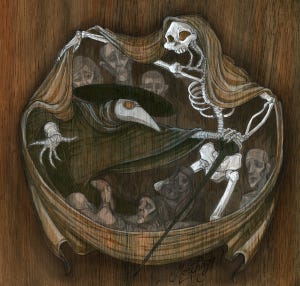Destruction Brings Creation
I'm guesting over at According to Hoyt today, in my regular monthly appearance there. I wrote up my presentation for the convention panel, and I suspect it will provoke some conversation.
Creative Destruction – Cedar Sanderson
I was introduced to this term this week when I was invited to create a presentation for a panel of this title. I’d never heard it before, and didn’t know precisely what it was all about, but the summary I was given sparked my imagination.
What can destructive forces create? What can they precipitate from the solution, sparking the coalescence of something new, and sometimes unpredictable, from human civilization catalyzed with tragedy?

I began my presentation with the Black Death in Europe. It’s the little things in life; that kill us and change our world. Fleas, in this case, carrying a disease between rats and humans. The numbers are soft, but estimates range around 25 million deaths from that epidemic, during the time it raged hotly over the continent, and many hundreds of thousands more in the centuries after. However, in the wake of all the death and destruction, there was change.
It is arguable that the Black Death led to the fall of serfdom, as labor was no longer readily and cheaply available – there simply weren’t enough bodies left standing. The plague led to the fall of the Roman Catholic Empire as it was, and the rise of Protestantism. And in a burst of pure creativity of the Arts, the Black Death led to the Renaissance, Shakespeare, and the glory that was that movement in art and literature.
But it was not the first time the plague had touched Western Civilization. Around 600 ad, the Justinian plague had struck, felling what was left of the Roman Empire, and establishing the course of the initial burst of European world domination. Both pandemics were much, much later confirmed to have the same originator, Yersinia pestis. It is the microscopic things.
There’s a song, which I can’t remember all the lyrics to (and I don’t know who performs it) but this much I recall: War! What is it good for?
The answer is deeply complex. (Read More at According to Hoyt...)
Commentator CACS recommends No Blade of Grass by John Christopher in response to my mention of a viroid that could threaten the whole world through the deaths of plants, not people.



